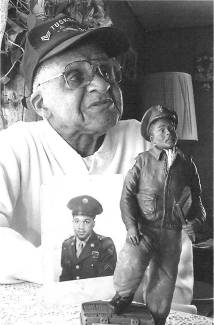Collection Name
About
Clifton Brooks (1922-2021)
Once the Tuskegee Airmen were activated in 1941 a search was undertaken for black pilots and support personnel. At the time, Clifton Brooks was at West Virginia State University studying mechanical engineering. He was to serve in the 332nd Fighter Group of the Tuskegee Airmen during World War II. Noting the racial inequality of that period, Brooks remembered not even being allowed on the bus that went from the air base to the Tuskegee Institute. Stationed in Italy during the 1940's, Brooks served as a Cryptographer and the head code technician. The following newspaper article (excerpts taken) written by Michael A. Sawyers and entitled “Knowing Code pays off for Keyser man who served with Tuskegee Airmen," appeared in the June 26, 2010 edition of the Cumberland Times-News:
"Clifton Brooks, 88, recently received a bronze replica of the Congressional Gold Medal that was presented in 2007 to the Tuskegee Airmen, a black aviator group for which he was a cryptographer during World War II. The presentation was made in Keyser by representatives of U.S. Rep. Alan Mollohan. In a Veterans Day 2005 interview with Times-News Staff Writer Michael Sawyers, Brooks proudly recalled his specialized service with a very special military organization.
'All the orders for the day were in code,' Brooks said. 'One day we sent the code that told the pilots they would go on a strafing mission, flying low to take out some ack-ack guns. They didn’t get the guns, but they spotted a German ship and sunk it. To my knowledge the code was never broken,' Brooks said. 'Twenty-five years after I got out of the Air Force, FBI agents would come to my house in Keyser. They wouldn’t interview me, but would talk to my relatives to see if I leaked any information about the code, because it was still being used.'
Brooks said he was instructed while in Italy that if Germans overran the operation he was to set off an incendiary bomb that would destroy the equipment. Because Sgt. Brooks’ knowledge of the code was considered so vital to military operations, he was to be consumed by the bomb as well, he said.
Following the war, Brooks worked for Kelly-Springfield Tire Co. until he retired in 1985."
Additional information from "Remembering those who served, Code of Silence: Keyser man was cryptographer with Tuskegee Airmen," by Michael A. Sawyers, Cumberland Times-News, November 11, 2005
Photo: Times-News File Photo by John A. Bone, 2005
